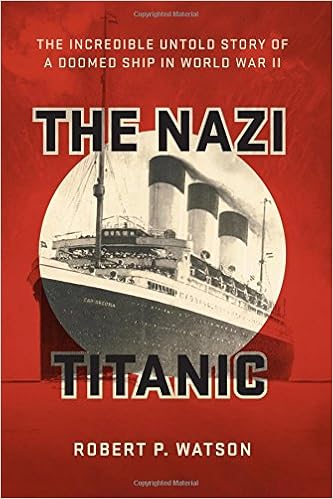
Free Downloads The Nazi Titanic: The Incredible Untold Story Of A Doomed Ship In World War II

Built in 1927, the German ocean liner SS Cap Arcona was the greatest ship since the RMS Titanic and one of the most celebrated luxury liners in the world. When the Nazis seized control in Germany, she was stripped down for use as a floating barracks and troop transport. Later, during the war, Hitler’s minister, Joseph Goebbels, cast her as the “star” in his epic propaganda film about the sinking of the legendary Titanic.Following the film’s enormous failure, the German navy used the Cap Arcona to transport German soldiers and civilians across the Baltic, away from the Red Army’s advance. In the Third Reich’s final days, the ill-fated ship was packed with thousands of concentration camp prisoners. Without adequate water, food, or sanitary facilities, the prisoners suffered as they waited for the end of the war. Just days before Germany surrendered, the Cap Arcona was mistakenly bombed by the British Royal Air Force, and nearly all of the prisoners were killed in the last major tragedy of the Holocaust and one of history’s worst maritime disasters.Although the British government sealed many documents pertaining to the ship’s sinking, Robert P. Watson has unearthed forgotten records, conducted many interviews, and used over 100 sources, including diaries and oral histories, to expose this story. As a result, The Nazi Titanic is a riveting and astonishing account of an enigmatic ship that played a devastating role in World War II and the Holocaust.Visit NaziTitanic.com

Hardcover: 312 pages
Publisher: Da Capo Press (April 26, 2016)
Language: English
ISBN-10: 0306824892
ISBN-13: 978-0306824890
Product Dimensions: 6.1 x 1.2 x 9.1 inches
Shipping Weight: 1 pounds (View shipping rates and policies)
Average Customer Review: 4.3 out of 5 stars See all reviews (32 customer reviews)
Best Sellers Rank: #27,451 in Books (See Top 100 in Books) #16 in Books > Engineering & Transportation > Transportation > History > Ships #21 in Books > Engineering & Transportation > Transportation > Ships #47 in Books > History > Europe > Germany

My son gave me a copy of The Nazi Titanic by Robert P. Watson for Father’s Day 2016. I enjoyed the book, but I also had some problems with it. So, let us start with the positive features of the book. It is very well written and well organized. Dr. Watson has used the Hamburg South American Steamship Line’s SS Cap Arcona as the main character in an account that spans the mid-1920’s to the end of World War Two. Along the way he provides a general overview of the war in Europe and well known personalities in Nazi Germany, and a few who are not so well known. He also adds details of some interesting events that are not usually included in a general recap of the war. One of the most interesting sections is the account of the Germans filming of their 1943 movie of the 1912 Titanic disaster, and the murder of the film’s director, Herbert Seplin, which takes up six chapters. The Cap Arcona was the film’s stand-in for RMS Titanic, and some of the scenes from the Germans’ 1943 production were used in the 1953 American film starring Clifton Webb and Barbara Stanwyck. The final eleven chapters first detail the ship’s use to evacuate German refugees from East Prussia as the Russians approached before turning to the ship’s use as a floating concentration camp in which thousands of trapped prisoners were murdered when the ship was sunk. For anyone not really familiar with the war in Europe, this is a good place to start because it provides a different approach to telling about the war in Europe and offers leads to further reading.And now the negative issues. As an historian, the absence of source notes is a drawback. But to be fair, most of the material used in this work is well known and needs no source citations, especially for a general audience.
The Nazi Titanic: The Incredible Untold Story of a Doomed Ship in World War II The Story of Titanic for Children: Astonishing Little-Known Facts and Details About the Most Famous Ship in the World The Nazi Hunters: How a Team of Spies and Survivors Captured the World's Most Notorious Nazi Titanic: A Nonfiction Companion to Magic Tree House #17: Tonight on the Titanic Titanic in Photographs (Titanic Collection) Exploring the Titanic: How the Greatest Ship Ever Lost was Found It's Your Ship: Management Techniques from the Best Damn Ship in the Navy, 10th Anniversary Edition The 100-Gun Ship Victory (Anatomy of the Ship) The Ship of the Line (A History in Ship Models) Robert Whyte's 1847 Famine Ship Diary: The Journey of an Irish Coffin Ship It's Your Ship: Management Techniques from the Best Damn Ship in the Navy (revised) A Higher Call: An Incredible True Story of Combat and Chivalry in the War-Torn Skies of World War II A Higher Calling: An Incredible True Story of Combat and Chivalry in the War-Torn Skies of World War II The Ship That Wouldn't Die: The Saga of the USS Neosho - A World War II Story of Courage and Survival at Sea The Alchemy of Air: A Jewish Genius, a Doomed Tycoon, and the Scientific Discovery That Fed the World but Fueled the Rise of Hitler Shanghai Grand: Forbidden Love and International Intrigue in a Doomed World Stealing Nazi Secrets in World War II (You Choose: Spies) The Incredible Hulk (Marvel: Incredible Hulk) (Little Golden Book) Angry Aztecs and Incredible Incas: AND Incredible Incas (Horrible Histories Collections) The Girls of Atomic City: The Untold Story of the Women Who Helped Win World War II



